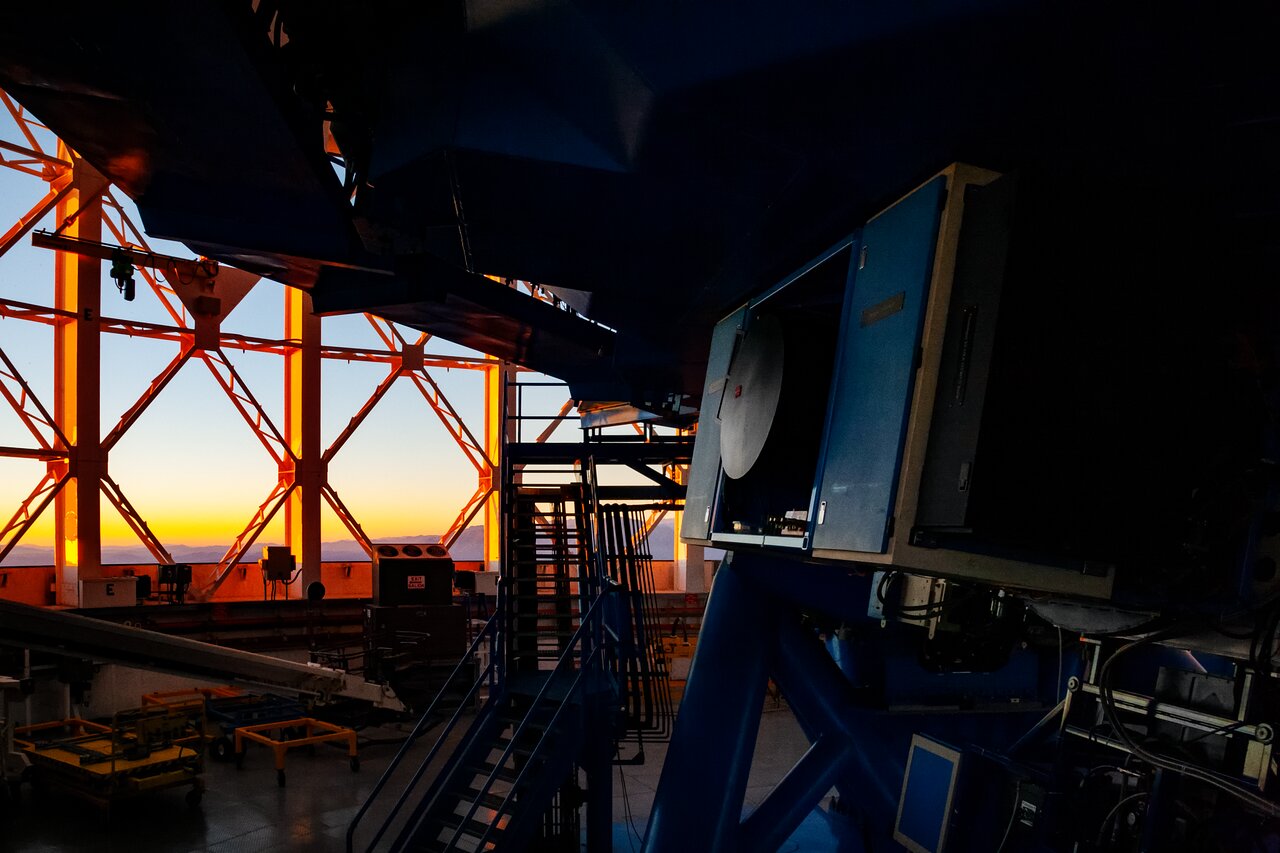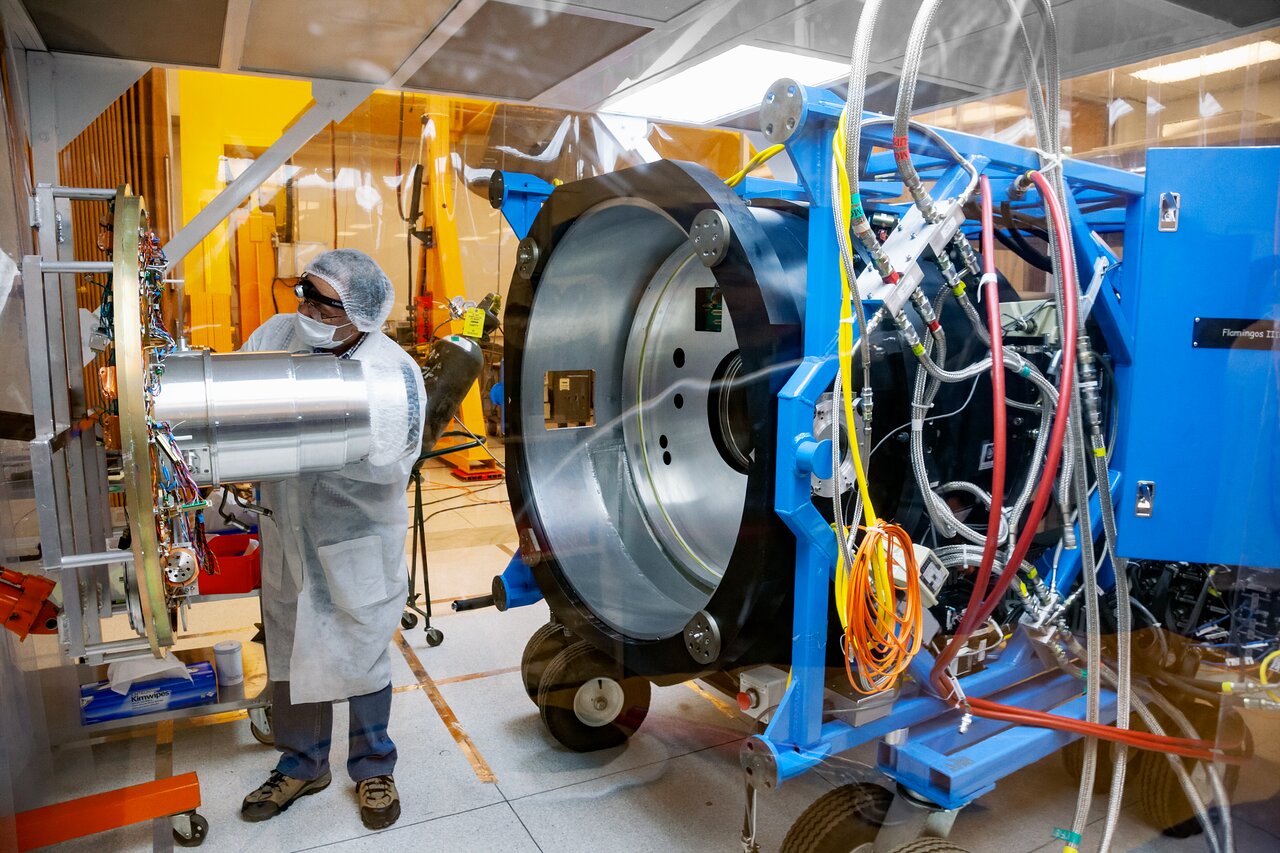FLAMINGOS-2

Credit: International Gemini Observatory/NOIRLab/NSF/AURA/M. Paredes
FLAMINGOS-2 commissioning at Gemini South.
The FLoridA Multi-object Imaging Near-infrared Grism Observational Spectrometer 2 (FLAMINGOS-2) is a near-infrared imager and multi-object spectrograph built by the University of Florida Astronomy Department and designed for use by the Gemini telescopes. This instrument differs from the original FLAMINGOS that was formerly at Kitt Peak National Observatory by being opto-mechanically optimized for the Gemini telescopes. Currently, FLAMINGOS 2 is stationed at Gemini South on Cerro Pachón.
It detects light in the 950–2500-nanometer wavelength range and operates in three modes: two spectroscopic modes — single long-slit, and multi-object spectroscopy (MOS) — and an imaging mode. It can work under natural seeing conditions as well as in conjunction with the Gemini Multi-Conjugate Adaptive Optics System (GeMS), a mode not yet commissioned. This versatility allows for a wide range of astronomical observations.
In single long-slit mode, a number of permanent slits are available: widths of 1, 2, 3, 4, 6, and 8 pixels; and lengths of 1467 pixels each. These slits can be used either with moderate- or higher-resolution grisms (or grating prisms). The f/16 and f/32 scales used in spectroscopy mode are the same as those in imaging mode.
In MOS mode, it can observe up to 150 targets at once. Sensitivity, observing efficiency, and spectral ranges are also the same as those of the long-slit mode; and a maximum of nine masks can be installed on the instrument per thermal cycle.
FLAMINGOS-2 has two guiding options: the F2 On-Instrument Wavefront Sensor, and the telescope’s Peripheral Wavefront Sensors.

NOIRLab Senior Mechanical Engineer Gabriel Perez performing regular maintenance tasks over FLAMINGOS-2.
Credit: International Gemini Observatory/NOIRLab/NSF/AURA/M. Paredes
Science Highlights of FLAMINGOS-2
- Record-Breaking Gamma-Ray Burst Possibly Most Powerful Explosion Ever Recorded
- The Earliest Supermassive Black Hole and Quasar in the Universe
- Astronomers Feast on First Light From Gravitational Wave Event
- The Beautiful Messiness of Star Birth
- Poised for Discovery
Quick Facts
|
|
FLoridA Multi-object Imaging Near-infrared Grism Observational Spectrometer 2 (FLAMINGOS-2) For scientists: Please find the most up-to-date details about the instrument offerings on the Gemini website. |
|
|
Site |
Cerro Pachón |
|
Telescope |
Gemini South |
|
Type |
Spectrograph |
|
Wavelength range |
0.9–2.5 μm |
|
Spatial sampling: |
0.18 arcseconds per pixel |
|
Number of detectors |
1 Teledyne HAWAII-2 array |
|
Detector format |
2048 x 2048 pixels |
|
Field of View |
Imaging — 6.1 arcminutes circular |
|
Spectral resolution: |
1000–3000 for 0.36-arcsecond slit |
|
Filters |
A set of broad- and medium-band filters are available for imaging and spectroscopy. |
|
Date of first light |
11 September 2009 |
|
Science Goals |
Deep near-infrared spectroscopy of stellar systems at the Galactic center, dust enshrouded young stellar objects, galaxy clusters and high-redshift objects. |
|
Images taken with the instruments |
|
|
Images of the instrument |
|
|
Videos of the Instrument |
|
|
Press releases with the instrument |
|